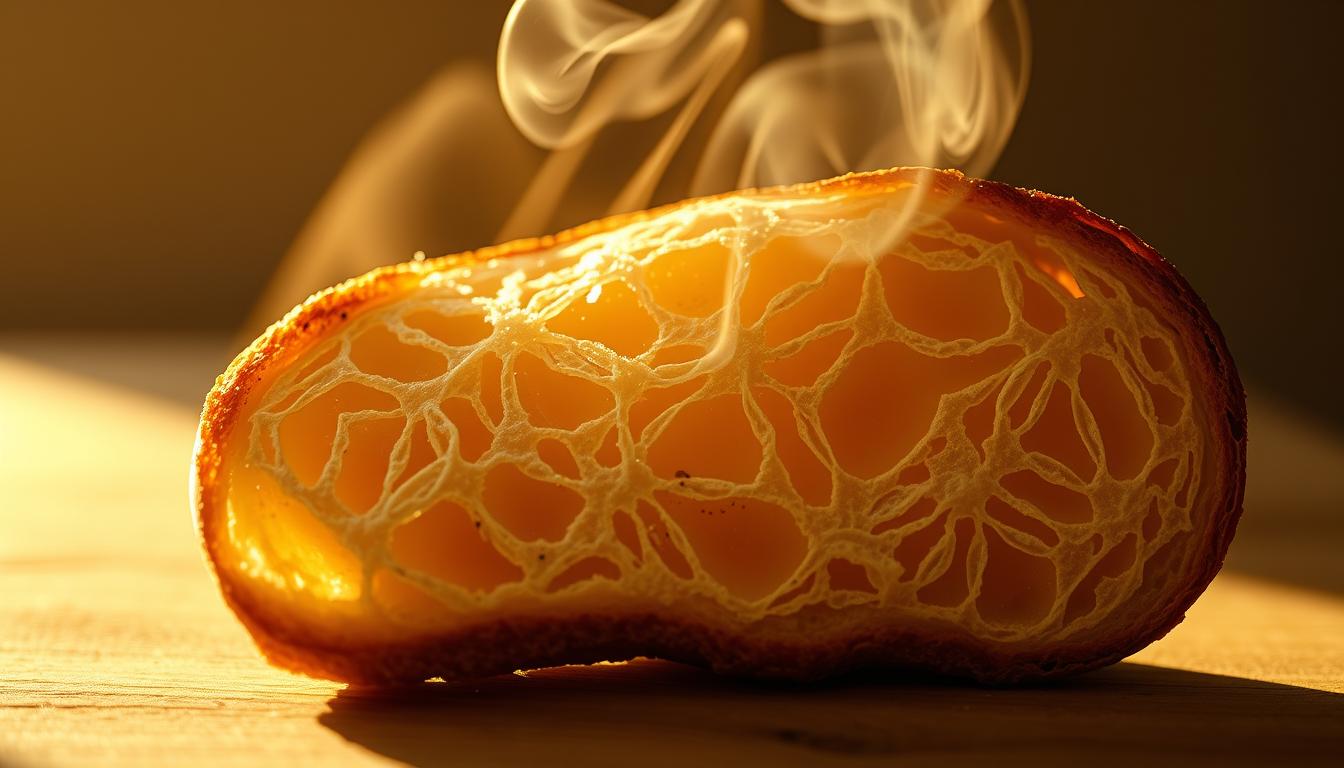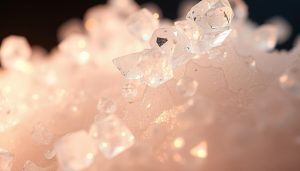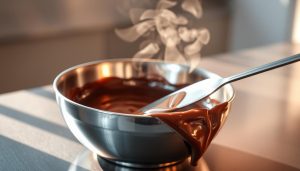Surprising research shows the Maillard reaction – the chemical process behind golden-brown toast – contributes over 70% of flavor development during heating. Yet most people treat this transformation as simple luck rather than precise science.
Turning plain slices into crispy perfection involves three hidden factors: energy distribution, moisture control, and timed molecular changes. Professional kitchens treat this as an exact thermal operation, not just a way to warm breakfast.
You’ll discover how infrared radiation interacts with starches while steam escapes through microscopic pores. Too much direct contact with heating elements? That’s why 1 in 3 slices ends up charred instead of caramelized.
The difference between soggy and crunchy lies in managing evaporation rates. Even your toaster’s settings work like a mini lab – balancing temperature gradients and reaction speeds most never consider.
Key Takeaways
- Flavor development relies on controlled chemical reactions, not random heating
- Infrared energy and conduction work together to transform texture
- Moisture escape patterns determine crispiness levels
- Time-temperature balance prevents carbonized edges
- Commercial equipment uses precision sensors missing in home appliances
Introduction
Every morning, millions transform simple slices into crispy perfection through a process they rarely analyze. Bread serves as a global staple, with toasted versions appearing on 78% of American breakfast tables weekly. In Iranian households, it provides over half of daily energy needs for low-income families – a nutritional lifeline hiding scientific complexity.

What you perceive as basic food preparation involves precise heat management most never consider. Professional chefs approach this task like engineers, balancing three critical factors:
- Energy absorption rates across porous surfaces
- Steam release through microscopic channels
- Chemical alterations at specific temperature thresholds
Your kitchen appliance becomes a thermal laboratory during operation. Research reveals that optimal crispiness requires removing exactly 13-17% moisture content while maintaining 140-160°C surface heat. Too little energy leaves slices rubbery; excessive application creates carbonized edges.
This daily ritual demonstrates food science principles in action. You’re not just warming slices – you’re directing molecular changes through controlled energy transfer. Understanding these mechanisms explains why identical settings produce different results across bread types.
Understanding the Science Behind Toasting
That golden crunch you love isn’t accidental – it’s chemistry in action. Behind every perfect slice lies precise interactions between molecules and thermal energy.

The Flavor Alchemy
The Maillard reaction transforms bread’s surface when amino acids meet sugars at 140-160°C (284-320°F). This process creates hundreds of flavor compounds and the brown crust you crave. Unlike caramelization, it requires proteins – making wheat’s gluten content critical.
Three factors control this reaction:
- Surface temperature hitting the sweet spot
- Moisture levels dropping below 15%
- Time allowing complex molecules to form
Energy in Motion
Heat reaches bread through three pathways:
| Method | Mechanism | Effect |
|---|---|---|
| Conduction | Direct contact with hot surfaces | Creates grill marks |
| Convection | Circulating hot air currents | Even drying |
| Radiation | Infrared waves | Penetrates crust |
As water evaporates, starch granules harden into the crispy network defining good toast. Professional kitchens monitor this using sensors – food chemistry principles guide their equipment designs.
Mastering these reactions lets you adjust variables for personalized results. Lower temperatures with longer exposure? You’ll enhance nutty flavors without bitterness. Understanding these interactions turns random heating into controlled culinary science.
The Thermodynamics of Toasting Bread
What transforms soft slices into crispy perfection? Hidden molecular shifts in carbohydrates and proteins make the difference. When heat reaches bread, two critical processes occur simultaneously – starch gelatinization and protein denaturation.

Starch’s Thermal Metamorphosis
Starch molecules absorb moisture and swell at 60-70°C (140-158°F). This gelatinization creates the crispy shell you love. Higher temperatures (above 150°C/302°F) dissolve these swollen granules, making bread more brittle.
Research shows a clear pattern:
- Longer exposure to moderate heat = Less starch dissolution
- Shorter high-heat bursts = More structural breakdown
Proteins Under Pressure
Heat unravels gluten proteins through denaturation. This process strengthens bread’s framework while trapping escaping steam. The result? A satisfying crunch instead of a limp texture.
Your toaster’s settings control these changes. Lower temperatures allow gradual moisture loss, preserving some starch structure. Higher heat forces rapid transformations – risking uneven results if timed poorly.
Understanding these interactions helps explain why sourdough toasts differently than whole wheat. Each bread’s unique carbohydrate and protein content responds distinctively to heat exposure.
Key Factors Influencing Toasting Outcomes
Precision heating separates average slices from culinary masterpieces. Achieving consistent results requires balancing four elements: heat intensity, exposure time, internal moisture paths, and ambient conditions. Even 10°C variations can shift outcomes from golden perfection to charcoal disaster.

Temperature Variations and Their Effects
Heat settings act like molecular traffic controllers. Higher temperature accelerates water evaporation while speeding up browning reactions. Research data reveals:
| Group | Temp Increase | Crust Temp Change | Weight Loss |
|---|---|---|---|
| Control | 190°C → 230°C | 128.5°C → 190.2°C | 35.11% → 47.23% |
| Test | 190°C → 230°C | 120.18°C → 164.8°C | 20.37% → 29.57% |
This table shows how bread composition alters heat response. Denser varieties resist moisture loss, requiring adjusted settings.
Moisture Content and Diffusion Dynamics
Water molecules race through bread‘s porous structure during heating. Optimal crispiness occurs when 13-17% moisture content evaporates uniformly. Three factors govern this process:
- Surface texture affecting steam escape routes
- Airflow patterns in cooking chambers
- Initial hydration levels in dough
Humidity plays a hidden role – high moisture environments slow crust formation. Professional chefs adjust time and temperature based on real-time steam detection, a feature missing in home appliances.
Mathematical Modeling and Experimental Analysis
Behind every perfectly browned slice lies a hidden world of equations and data. Food scientists employ advanced computational models to predict how heat and moisture interact during the toasting process. These tools transform guesswork into precise predictions.

Governing Equations and Boundary Conditions
Core calculations focus on two critical balances:
- Heat transfer: ρCP∂T/∂t = 1/r∂/∂r(rk∂T/∂r)
- Mass transfer: ∂W/∂t = 1/r∂/∂r(rD∂W/∂r)
Boundary conditions define how heat escapes through the crust while moisture migrates outward. Guar gum-enriched bread shows 7% slower water diffusion than standard loaves in testing scenarios.
Interpreting Experimental Data and Results
Controlled tests reveal clear patterns:
| Bread Type | Moisture Loss | Temp Rise |
|---|---|---|
| Control | 35.11% → 47.23% | 128.5°C → 190.2°C |
| Guar Gum | 20.37% → 29.57% | 120.18°C → 164.8°C |
This data helps refine models using MATLAB simulations. Polynomial functions predict 89% of weight loss variations, while Gaussian patterns map temperature spikes.
Through repeated testing, researchers validate equations against real-world results. You’ll find optimized settings emerge when equations account for initial moisture levels and surface porosity – key factors most toasters ignore.
Practical Applications in Toaster Technology
Modern toasters are marvels of food engineering, transforming breakfast routines through calculated heat management. Your morning appliance uses precise thermal principles to balance speed and quality, achieving what once required professional equipment.

Design Innovations and Heat Distribution
Advanced models now feature zigzag heating elements and polished reflectors. These components work together to direct infrared energy across bread surfaces evenly. By adjusting cavity geometry, engineers create optimal airflow patterns that remove moisture without overdrying.
Three breakthroughs enhance performance:
- Dual-zone sensors adapt to bread thickness in real time
- Ceramic coatings improve radiant heat transfer by 22%
- Variable-speed fans manage steam escape routes
Your toaster’s heat transfer coefficient – a measure of thermal efficiency – determines how quickly energy reaches the core. Premium designs maintain coefficients between 25-35 W/m²K, ensuring consistent results across different types of bread. This precision prevents burnt edges while locking in flavor compounds formed during heating.
Manufacturers use computational models to test thousands of design variations. The best configurations reduce energy use by 18% compared to older models. Next time you press the lever, remember: you’re activating a system refined through decades of thermodynamic research.
Research Insights and Comparative Studies
Scientific breakthroughs reveal hidden variables shaping your morning ritual. Recent studies demonstrate how minor ingredient changes alter heat responses in ways invisible to the naked eye.
Flour Additives & Structural Impacts
Guar gum alters moisture dynamics significantly. Bread with 1% additive retains 12% more water during heating compared to standard recipes. This creates softer interiors while delaying crust formation.
| Bread Type | Initial Moisture | Crust Temp | Weight Loss |
|---|---|---|---|
| Control | 0.58 db | 128°C | 35% |
| Guar Gum | 0.62 db | 121°C | 28% |
Protein content proves equally critical. High-gluten flour creates tighter networks that resist steam escape, producing thicker crusts. Test results show 14% faster browning in protein-rich doughs.
Baking Parameter Optimization
Time-temperature combinations determine starch behavior. Extended 18-minute bakes at 160°C dissolve 23% less starch than 12-minute cycles at 190°C. This preserves structural integrity while enhancing crunch.
| Method | Duration | Heat | Starch Change |
|---|---|---|---|
| Slow bake | 18 min | 160°C | 42% dissolution |
| Fast bake | 12 min | 190°C | 65% dissolution |
Fermentation duration also plays a role. Well-developed doughs with longer proofing times toast more evenly due to consistent pore distribution. Your choice of flour and additives directly impacts these outcomes.
Tips and Best Practices for Perfect Toast
Achieving golden-brown perfection requires more than just pushing a lever. Three elements make the difference: precise heat application, calculated timing, and controlled moisture escape. Your appliance becomes a precision instrument when you match settings to each loaf’s characteristics.
Mastering the Browning Equation
Dry heat activates the Maillard reaction best between 120-160°C (250-350°F). Start with fully thawed slices – ice crystals create steam that hinders flavor development. Thicker cuts need lower temperatures for longer to penetrate without burning surfaces.
Adjust your toaster’s darkness dial as a countdown timer. Lighter settings preserve subtle nutty notes, while darker levels intensify caramelized tastes. For sourdough or rye, reduce heat by one level – their dense structures brown faster than white bread.
Rotate slices halfway through cooking if your appliance lacks even heating. This ensures uniform crispness across the surface. Let finished pieces rest 45 seconds – escaping steam completes the textural transformation from soggy to crunchy.
Remember: great toast balances flavor and texture through controlled energy input. Apply these principles, and you’ll turn morning routines into delicious demonstrations of food science.



